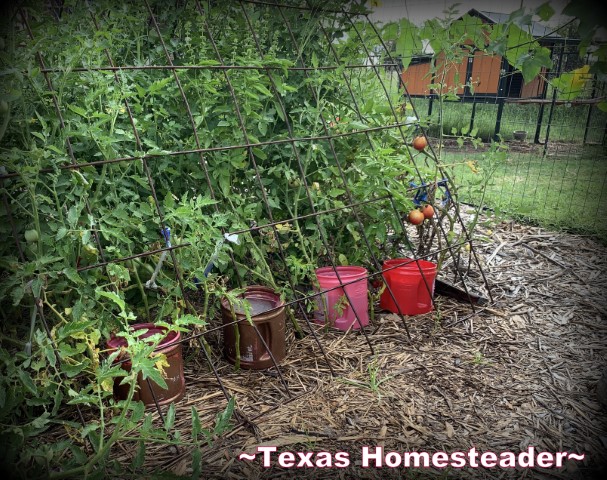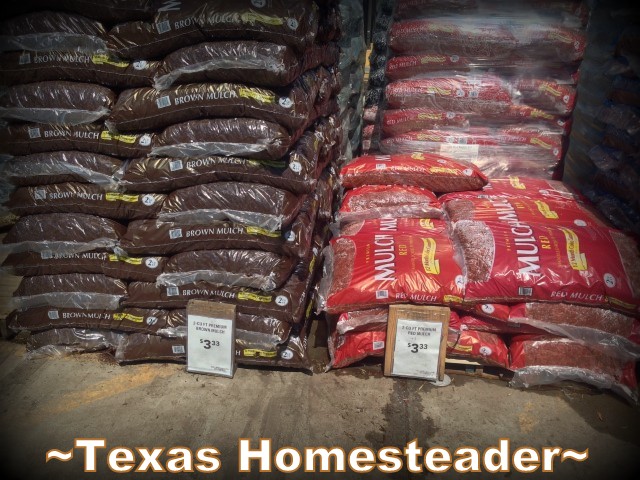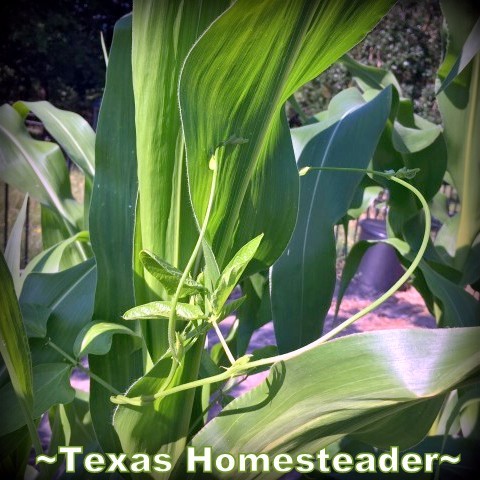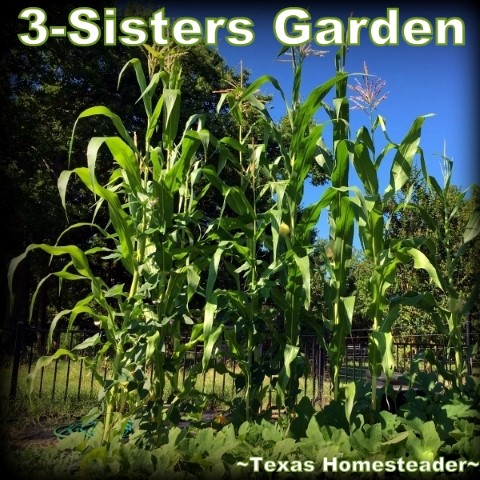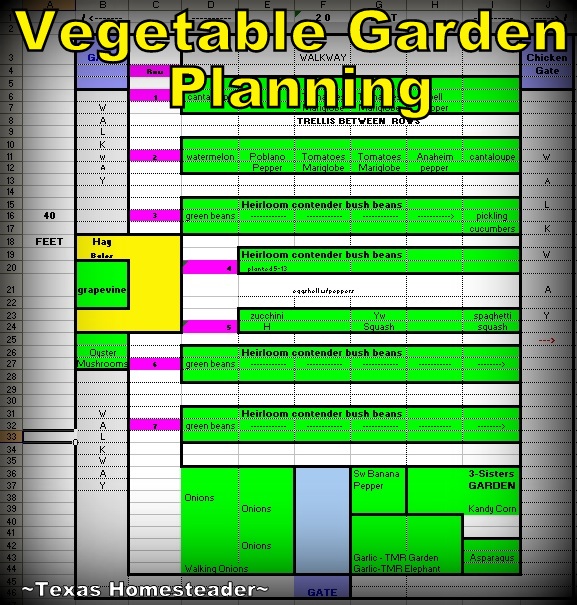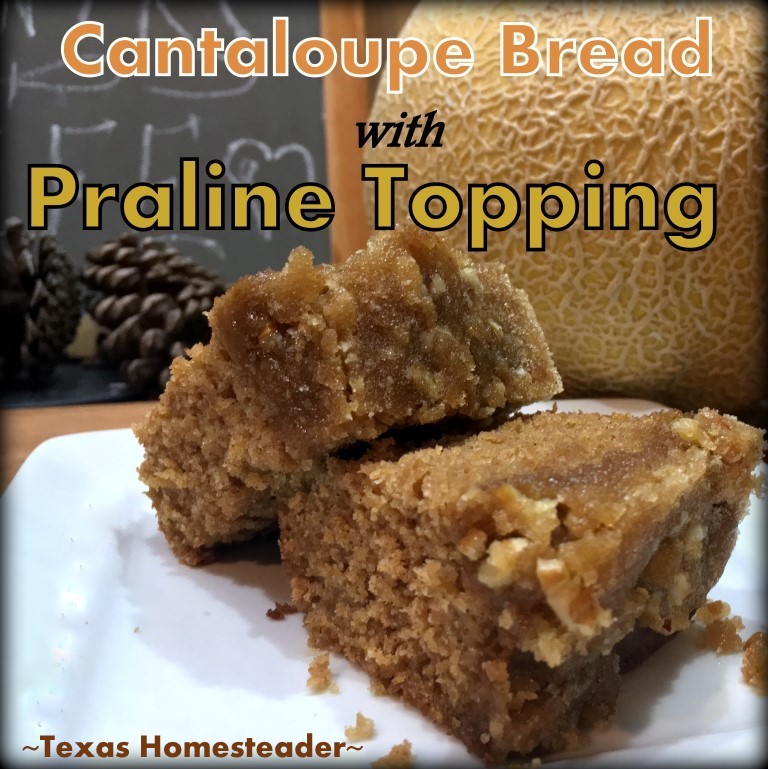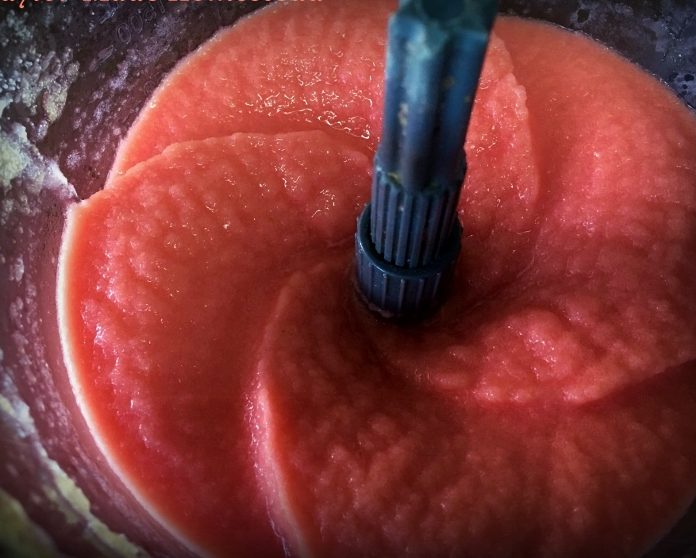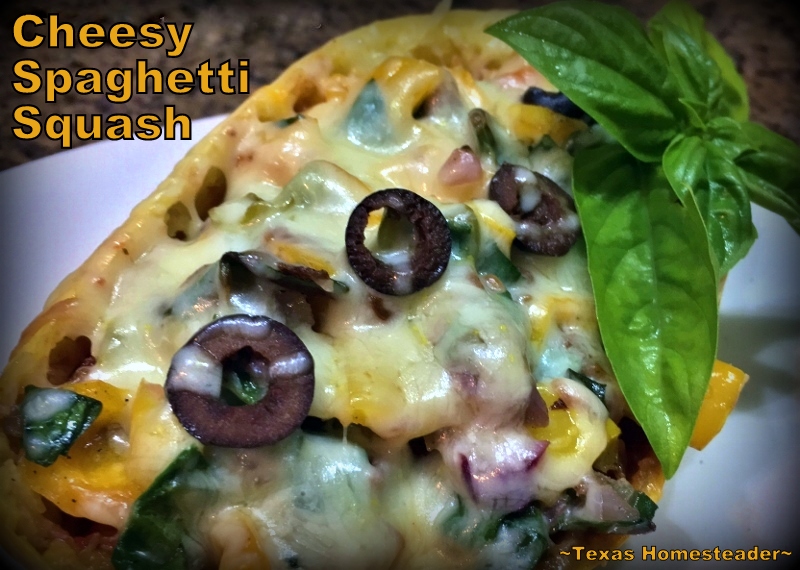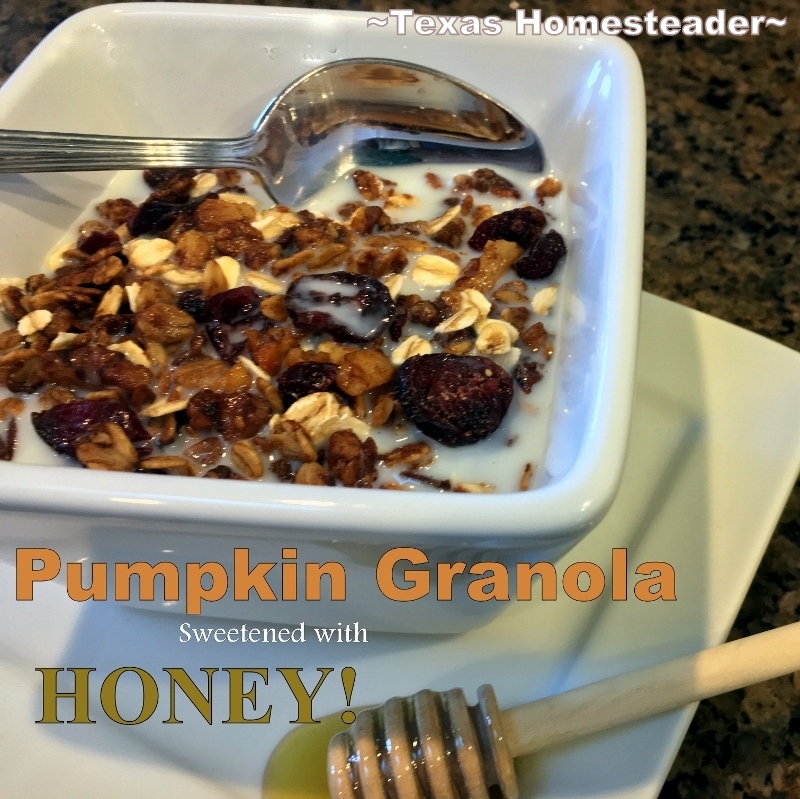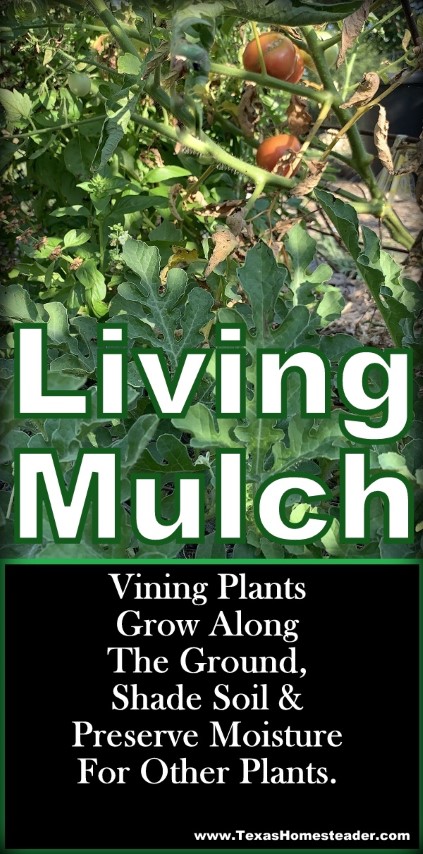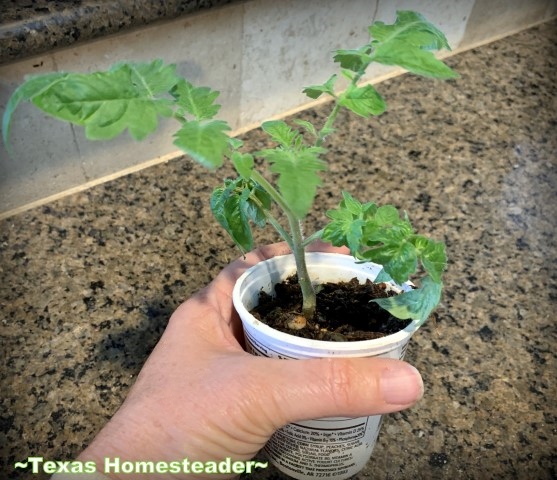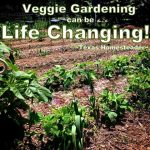by Texas Homesteader ~
Garden plants benefit from mulch to shade the ground. Not only does mulch moderate soil temps during the hot days of summer but it preserves moisture too.
For living mulch I use plants that grow in long vines along the ground. Check out this work-saving Homestead Hack, y’all!
A Green Solution: Many Benefits of Mulch In The Garden
Here in NE Texas the summers can be hot and dry. So veggie garden plants benefit and are protected by using mulch to cover the soil.
It protects it from the drying heat of that brutal Texas summer sun. And it also helps preserve the precious moisture that can be zapped by the hot and dry summer months too .
What Can You Use As Mulch?
There are many things I use as mulch in my Homestead gardens:
Dried grass clippings – free and natural (be sure to dry first so you don’t burn your plants)
Free Wood Mulch from tree trimming/mulching companies
Spent hay from around hay rings (be sure to use only hay that has not been sprayed with herbicides)
As a last resort you can buy bags of commercial mulch from retailers.
But for my vegetable garden I’m using something even easier. And it’s still all natural and eco friendly. Something that doesn’t need to be purchased in a plastic bag nor hauled to the garden.
No hoe or rake to spread, no extra work at all. Plus it feeds me too!
Eco Friendly Gardening: Use Vining Plants As Mulch In The Garden
When looking for mulch options in my garden I like to let Mother Nature do the work! I took a tip from the 3 Sisters Garden strategy commonly used by Native American Indians and early settlers.
Corn was a dietary staple for them. So in their 3 Sisters Garden they started by planting corn. But corn is a heavy feeder & pulls much nutrition from the ground to grow.
So green beans are planted at the base of each corn plant to provide nitrogen for the corn. But the corn stalk provides a structure for the green beans to grow upon. Both plants benefit each other so both can grow strong.
Finally, vining squash is planted between each corn/green bean plantings. The squash grows into long vines that amble around & covers the ground around the plantings.
Those large leaves growing along the ground provide important shade for the soil. That helps preserve moisture for the corn and beans, and also keeps the soil temps more moderated from the hot sun.
All three plants benefit both from as well as for each other in this beautiful symbiotic growing plan.
Planting Vining Plants For Living Mulch
Then I got to thinking hummmmm… I really like the living mulch theory used in the 3-sister’s garden. Maybe I can use it throughout my entire garden-planting plan.
So each year when I’m Planning My Vegetable Garden I often include a vining plant to be planted at the ends of my garden rows.
I’ll use those vining plants as living mulch.
What Vining Plants Can Be Used As Living Mulch?
I don’t plant the same plant to use as living mulch on all rows. I’ll change it up so I’ll get more food from this dual-purpose planting.
In my garden there are several options for vining plants I use for living mulch:
Cantaloupe – I love to eat it fresh or make Cantaloupe Bread (similar to zucchini bread but with sweet cantaloupe)
Watermelon – RancherMan & I freeze the fresh melon cubes and use them for a cold, refreshing Watermelon Smoothie or Daiquiri.
Spaghetti Squash – I make it cheesy and lasagna style. Plus it’s prolific so there’s plenty to share with friends & family.
Pumpkin – It’s beautiful used in fall decorations, then I cook & puree it to make RancherMan’s favorite Pumpkin Granola.
See what I mean? Lots of food coming from just ‘mulch‘!
How Vining Plants As Living Mulch Benefits The Garden
You may wonder how many benefits you actually see from planting this living mulch? Well there are lots of reasons using vining plants as living mulch outweighs purchased mulch in your garden:
Nearly FREE! Costs only a seed or two.
Less Work. No hauling bags of mulch and spreading, then finding a way to dispose of plastic packaging trash. Just plant a seed!
Water Conservation. Shading the soil makes moisture evaporation slower leaving more moisture for your plants. Enjoy less frequent watering.
Eco Friendly. No disposable plastic bag trash required.
Create Protective Layer for Plant Roots. Shading the soil keeps soil temperatures and root zones cooler in the hot months.
Weed Suppression. Living mulch keeps many weeds from popping up by covering the soil.
Provides Food. Unlike bagged mulch, living mulch actually provides FOOD!
Nutrient Rich Compost Material. Simply pull up the plants at the end of the season and add to your composter.
That’s a whole lot of benefit from just watching for smarter ways to mulch your garden, y’all! #WorkSmarterNotHarder
How Mulch Benefits Tomato Plants
I’ve written before about Tips For Growing The Best Tomatoes. Adding this living mulch really helps all plants, but especially tomatoes.
Tomatoes are warm-weather crops. So they enjoy the soil being heated up in the early spring months. When I first transplant tomatoes into the garden I don’t bother mulching them at all. We’ll get plenty of rain for moisture and the soil will heat as the season goes on.
But after a while it starts getting too warm. It’s then that they can benefit from some shading of their roots.
PLUS, tomato plants don’t like to have soil splashed on their leaves when watering. So on the ends of my tomato rows I often plant cantaloupe.
The cantaloupe vines grow long and by the time the temps are heating up they are long enough to ramble through the rows of tomatoes. So I just allow them to grow beneath, around & beyond the tomato plants.
The tomato bushes help shade the cantaloupe vines too, so once again they benefit each other.
Happy Gardening!
~TxH~
My Favorite Garden Hacks
Garden Planning
- Easy Garden Planting Plan Spreadsheet
- Prepare Now! Late-Winter Garden Checklist
- How To Make Your Own Garden Soil
- Prepare Your Garden For Spring Planting
Seed Planting
- Planting Seeds In A Milk Jug Mini-Greenhouse
- Planting A Clear Tote As An Indoor Greenhouse
- Repurposed Cardboard Seed-Starting Pots
Soil Health
- Easy Compost For A Healthy Garden
- How Leaves Benefit Your Garden
- Using Manure In Your Compost & Garden
Garden Styles
- How & Why To Use Raised Beds In Your Garden
- 3-Sister’s Garden – The Original Companion Planting
- Planting A Large Galvanized Trough
- Where I Found The BEST Raised Bed!
- Planting A Blueberry Bush In Rustic Galvanized Tub
Garden Plants/Harvest
- Stevia – Growing Your Own Sweetener!
- My Simple, Zero-Waste Herb Drying Setup
- The Lazy Gardener’s Plant List – Plant Once, Eat For Years!
- How To Tell When Watermelon Is Ripe
- Luffa A Surprising Zucchini Substitute!
- How To Plant & Grow The Best Tomatoes
Water/Irrigation/Drought
- Keeping Potted Plants Watered
- Repurposing A Coffee Can For Deep-Soak Watering
- 3 Rainwater Collection Systems We Use
- Cheap (or FREE) Wood Mulch For The Garden
- Using Vining Plants For Living Mulch
- Surprising Use For Empty Clay Pots In The Garden
Weed Control
Garden Tips
- How To Save Outdoor Plants Even During A Hard Freeze
- Tricking Birds AWAY From Your Strawberry Plants
- Protecting Tender Seedlings From Wind
- Homestead Hack: Remember Where You Planted Seeds
- How I Use EcoBricks In The Garden
MORE Gardening Posts
C’mon by & sit a spell! Come hang out at our Facebook Page. It’s like sitting in a front porch rocker with a glass of cold iced tea. Lots of good folks sharing!
You can also follow along on Pinterest, on Twitter or on Instagram.


